Lazar Kaganovich
Lazar Moiseyevich Kaganovich (Russian: Ла́зарь Моисе́евич Кагано́вич; 22 November [O.S. 10 November] 1893 – 25 July 1991) was a Soviet politician and administrator and one of the main associates of Joseph Stalin. He is known for helping Stalin seize power, for his role in organizing, planning and supervising the Holodomor, and for his harsh treatment and execution of those deemed threats to Stalin's regime. He was project manager and led the original design team of the Moscow Metro, and Moscow's Metro was named after him until 1955.[1]
Lazar Kaganovich Ла́зарь Кагано́вич | |||||||||||||||||||||||||||||||||||||||||||||||||||||||||||
|---|---|---|---|---|---|---|---|---|---|---|---|---|---|---|---|---|---|---|---|---|---|---|---|---|---|---|---|---|---|---|---|---|---|---|---|---|---|---|---|---|---|---|---|---|---|---|---|---|---|---|---|---|---|---|---|---|---|---|---|
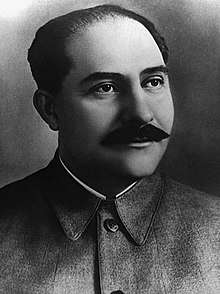 | |||||||||||||||||||||||||||||||||||||||||||||||||||||||||||
| First Deputy Chairman of the Council of Ministers of the Soviet Union | |||||||||||||||||||||||||||||||||||||||||||||||||||||||||||
| In office 5 March 1953 – 29 June 1957 | |||||||||||||||||||||||||||||||||||||||||||||||||||||||||||
| Premier | Georgy Malenkov Nikolai Bulganin Nikita Khrushchev | ||||||||||||||||||||||||||||||||||||||||||||||||||||||||||
| Preceded by | Lavrentiy Beria | ||||||||||||||||||||||||||||||||||||||||||||||||||||||||||
| Succeeded by | Anastas Mikoyan | ||||||||||||||||||||||||||||||||||||||||||||||||||||||||||
| Deputy Chairman of the Council of Ministers of the Soviet Union | |||||||||||||||||||||||||||||||||||||||||||||||||||||||||||
| In office 18 December 1947 – 5 March 1953 | |||||||||||||||||||||||||||||||||||||||||||||||||||||||||||
| Premier | Joseph Stalin | ||||||||||||||||||||||||||||||||||||||||||||||||||||||||||
| In office 19 March 1946 – 6 March 1947 | |||||||||||||||||||||||||||||||||||||||||||||||||||||||||||
| Premier | Joseph Stalin | ||||||||||||||||||||||||||||||||||||||||||||||||||||||||||
| In office 21 August 1938 – 15 May 1944 | |||||||||||||||||||||||||||||||||||||||||||||||||||||||||||
| Premier | Vyacheslav Molotov Joseph Stalin | ||||||||||||||||||||||||||||||||||||||||||||||||||||||||||
| First Secretary of the Communist Party of Ukraine (Bolsheviks) | |||||||||||||||||||||||||||||||||||||||||||||||||||||||||||
| In office 3 March – 26 December 1947 | |||||||||||||||||||||||||||||||||||||||||||||||||||||||||||
| Preceded by | Nikita Khrushchev | ||||||||||||||||||||||||||||||||||||||||||||||||||||||||||
| Succeeded by | Nikita Khrushchev | ||||||||||||||||||||||||||||||||||||||||||||||||||||||||||
| In office 7 April 1925 – 14 July 1928 | |||||||||||||||||||||||||||||||||||||||||||||||||||||||||||
| Preceded by | Emanuel Kviring | ||||||||||||||||||||||||||||||||||||||||||||||||||||||||||
| Succeeded by | Stanislav Kosior | ||||||||||||||||||||||||||||||||||||||||||||||||||||||||||
| |||||||||||||||||||||||||||||||||||||||||||||||||||||||||||
| Personal details | |||||||||||||||||||||||||||||||||||||||||||||||||||||||||||
| Born | Lazar Moiseyevich Kaganovich 22 November 1893 Kabany, Kiev Governorate, Russian Empire | ||||||||||||||||||||||||||||||||||||||||||||||||||||||||||
| Died | 25 July 1991 (aged 97) Moscow, Russian SFSR, Soviet Union | ||||||||||||||||||||||||||||||||||||||||||||||||||||||||||
| Nationality | Soviet | ||||||||||||||||||||||||||||||||||||||||||||||||||||||||||
| Political party | RSDLP (1911-1912) RSDLP (Bolsheviks) (1912-1918) Russian Communist Party (1918-1961) | ||||||||||||||||||||||||||||||||||||||||||||||||||||||||||
| Signature | |||||||||||||||||||||||||||||||||||||||||||||||||||||||||||
At his death in 1991, he was the last surviving Old Bolshevik.[2] The Soviet Union itself outlived him by a mere five months before it finally disintegrated.
Early life
Kaganovich was born in 1893 to Jewish parents[3] in the village of Kabany, Radomyshl uyezd, Kiev Governorate, Russian Empire (now named Dibrova, Poliske Raion, Kiev Oblast, Ukraine).
Around 1911, he joined the Bolshevik party (his older brother Mikhail Kaganovich had become a member in 1905).[4] Early in his political career, in 1915, Kaganovich became a Communist organizer at a shoe factory where he worked.[4] During the same year he was arrested and sent back to Kabany.[4]
Revolution and Civil War
During March and April 1917, he served as the Chairman of the Tanners Union and as the vice-chairman of the Yuzovka Soviet. In May 1917, he became the leader of the military organization of Bolsheviks in Saratov, and in August 1917, he became the leader of the Polessky Committee of the Bolshevik party in Belarus. During the October Revolution of 1917 he led the revolt in Gomel.
In 1918 Kaganovich acted as Commissar of the propaganda department of the Red Army. From May 1918 to August 1919 he was the Chairman of the Ispolkom (Committee) of the Nizhny Novgorod gubernia. In 1919–1920, he served as governor of the Voronezh gubernia. The years 1920 to 1922 he spent in Turkmenistan as one of the leaders of the Bolshevik struggle against local Muslim rebels (basmachi), and also commanding the succeeding punitive expeditions against local opposition.
Communist functionary
In May 1922, Stalin became the General Secretary of the Communist Party and immediately transferred Kaganovich to his apparatus to head the Organizational Bureau or Orgburo of the Secretariat. This department was responsible for all assignments within the apparatus of the Communist Party. Working there, Kaganovich helped to place Stalin's supporters in important jobs within the Communist Party bureaucracy. In this position he became noted for his great work capacity and for his personal loyalty to Stalin. He stated publicly that he would execute absolutely any order from Stalin, which at that time was a novelty.
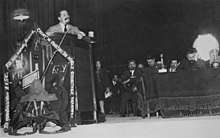
In 1924, Kaganovich became a full member of the Central Committee, after having first been elected as a candidate one year earlier. From 1925 to 1928, Kaganovich was the First Secretary of the Communist Party of the Ukrainian SSR. He was given the task of "ukrainizatsiya" – meaning at that time the building up of Ukrainian communist popular cadres. He also had the duty of implementing collectivization and the policy of economic suppression of the kulaks (wealthier peasants). He opposed the more moderate policy of Nikolai Bukharin, who argued in favor of the "peaceful integration of kulaks into socialism". In 1928, due to numerous protests against Kaganovich's management, Stalin was forced to transfer Kaganovich from Ukraine to Moscow, where he returned to his position as a Secretary of the Central Committee of the Communist Party, a job he held until 1939. As Secretary, he endorsed Stalin's struggle against the so-called Left and Right Oppositions within the Communist Party, in the hope that Stalin would become the sole leader of the country. In 1933 and 1934, he served as the Chairman of the Commission for the Vetting of the Party Membership (Tsentralnaya komissiya po proverke partiynykh ryadov) and ensured personally that nobody associated with anti-Stalin opposition would be permitted to remain a Communist Party member. In 1934, at the XVII Congress of the Communist Party, Kaganovich chaired the Counting Committee. He falsified voting for positions in the Central Committee, deleting 290 votes opposing the Stalin candidacy. His actions resulted in Stalin's being re-elected as the General Secretary instead of Sergey Kirov. By the rules, the candidate receiving fewer opposing votes should become the General Secretary. Before Kaganovich's falsification, Stalin received 292 opposing votes and Kirov only three. However, the "official" result (due to the interference of Kaganovich) saw Stalin with just two opposing votes (Radzinsky, 1996).
In 1930, Kaganovich became a member of the Soviet Politburo and the First Secretary of the Moscow Obkom of the Communist Party (1930–1935). He later headed the Moscow Gorkom of the Communist Party (1931–1934). He also supervised the implementation of many of Stalin's economic policies, including the collectivization of agriculture and rapid industrialization. During this period, he also supervised the destruction of many of the city's oldest monuments, including the Cathedral of Christ the Saviour.[5] In 1932, he led the suppression of the workers' strike in Ivanovo-Voznesensk.
Moscow Metro
On June 15, 1931, at the Plenum of the Central Committee of the All-Union Communist Party of Bolsheviks, after a report by the first secretary of the Moscow City Party Committee, Lazar Kaganovich, a decision was made to build the Moscow metro to improve the transport situation in the city and partially relieve tram lines.
In the 1930s, Kaganovich - along with project managers Ivan Kuznetsov and, later - Isaac Segal, organized and led the building of the first Soviet underground rapid-transport system, the Moscow Metro, known as Metropoliten imeni L.M. Kaganovicha after him until 1955.
On October 15, 1941, L. M. Kaganovich received an order to close the Moscow Metro, and within 3 hours to prepare proposals for its destruction, as a strategically important object. The metro was supposed to be destroyed, and the remaining cars and equipment removed. On the morning of October 16, 1941, on the day of the panic in Moscow, the metro was not opened for the first time. It was the only day in the history of the Moscow metro when it did not work. By evening, the order to destroy the metro was canceled.
In 1955, after the death of Stalin, the Moscow Metro was renamed to no longer include Kaganovich's name.
Responsibility for 1932–33 famine
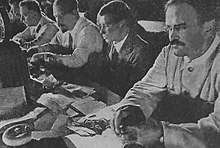
Kaganovich (together with Vyacheslav Molotov) participated with the All-Ukrainian Party Conference of 1930 and were given the task of implementation of the collectivization policy that caused a catastrophic 1932–33 famine (known as the Holodomor in Ukraine). Similar policies also inflicted enormous suffering on the Soviet Central Asian republic of Kazakhstan, the Kuban region, Crimea, the lower Volga region, and other parts of the Soviet Union. As an emissary of the Central Committee of the Communist Party, Kaganovich traveled to Ukraine, the central regions of the USSR, the Northern Caucasus, and Siberia demanding the acceleration of collectivization and repressions against the Kulaks, who were generally blamed for the slow progress of collectivization. Attorney Rafael Lemkin in his work The Soviet Genocide in Ukraine tried to present the fact of Holodomor to the Nuremberg trials as a genocide of a totalitarian regime.[6]
On 13 January 2010, Kiev Appellate Court posthumously found Kaganovich, Postyshev, Kosior, Chubar and other Soviet Communist Party functionaries guilty of genocide against Ukrainians during the catastrophic Holodomor famine.[7] Though they were pronounced guilty as criminals, the case was ended immediately according to paragraph 8 of Article 6 of the Criminal Procedural Code of Ukraine.[8] By New Year's Day, the Security Service of Ukraine had finished pre-court investigation and transferred its materials to the Prosecutor General of Ukraine. The materials consist of over 250 volumes of archive documents (from within Ukraine as well as from abroad), interviews with witnesses, and expert analysis of several institutes of National Academies of Sciences. Oleksandr Medvedko, the Prosecutor General, stated that the material proves that a genocide occurred in Ukraine.
"Iron Lazar"
From 1935 to 1937, Kaganovich worked as Narkom (Minister) for the railways. Even before the start of the Great Purges, he organized the arrests of thousands of railway administrators and managers as supposed "saboteurs".
From 1937 to 1939, Kaganovich served as Narkom for Heavy Industry. During 1939–1940, he served as Narkom for the Oil Industry. Each of his assignments was associated with arrests in order to improve discipline and compliance with Stalin's policies.
In all Party conferences of the later 1930s, he made speeches demanding increased efforts in the search for and prosecution of "foreign spies" and "saboteurs". For his ruthlessness in the execution of Stalin's orders, he was nicknamed "Iron Lazar". During the period of the Great Terror, starting in 1936, Kaganovich's signature appears on 188 out of 357 documented execution lists.[9]
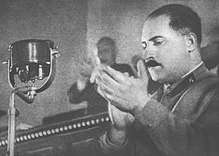
One of many who perished during these years was Lazar's brother, Mikhail Kaganovich, who was People's Commissar of the Aviation Industry. On 10 January 1940 Mikhail was demoted to director of aviation plant 124 in Kazan. In February 1941, during the 18th Conference of the Communist Party, Mikhail was warned that if the plant missed its quotas he would be eliminated from the Party. On 1 June 1941 Stalin mentioned to Lazar that he had heard that Mikhail was "associating with the right wing". Lazar reportedly did not speak in the defence of his brother to Stalin, but did notify him by telephone. The same day Mikhail committed suicide.[10]
During his time serving as Railways Commissar, Kaganovich participated in the murder of 36,000 people by signing death lists. Kaganovich had exterminated so many railwaymen that one official called to warn that one line was entirely unmanned.[11]
During World War II (known as the Great Patriotic War in the USSR), Kaganovich was Commissar (Member of the Military Council) of the North Caucasian and Transcaucasian Fronts. During 1943–1944, he was again the Narkom for the railways. In 1943, he was presented with the title of Hero of Socialist Labour. From 1944 to 1947, Kaganovich was the Minister for Building Materials.
In 1947, he became the First Secretary of the Ukrainian Communist Party. From 1948 to 1952, he served as the Chairman of Gossnab (State Committee for Material-Technical Supply, charged with the primary responsibility for the allocation of producer goods to enterprises, a critical state function in the absence of markets), and from 1952 to 1957, as the First Vice-Premier of the Council of Ministers. He was also the first Chairman of Goskomtrud (State Committee for Labour and Wages, charged with introducing the minimum wage, with other wage policy, and with improving the old-age pension system).
Until 1957, Kaganovich was a voting member of the Politburo as well as the Presidium. He was also an early mentor of the eventual First Secretary of the Communist Party Nikita Khrushchev, who first became important as Kaganovich's Moscow City deputy during the 1930s. In 1947, when Khrushchev was dismissed as the Party secretary of Ukraine (he remained in the somewhat lesser "chief of government" position), Stalin dispatched Kaganovich to replace him until Khrushchev was reinstated later that year.
Later life
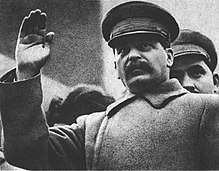
Kaganovich was a doctrinaire Stalinist, and though he remained a member of the Presidium, he quickly lost influence after Stalin's death in March 1953. In 1957, along with fellow devoted Stalinists as well as other opponents of Khrushchev, Molotov, Dmitri Shepilov and Georgy Malenkov (the so-called Anti-Party Group), he participated in an abortive party coup against his former protégé Khrushchev, whose criticism of Stalin had become increasingly harsh during the preceding two years. As a result of the unsuccessful coup, Kaganovich was forced to retire from the Presidium and the Central Committee, and was given the job of director of a small potash works in the Urals.[12] In 1961, Kaganovich was completely expelled from the Party and became a pensioner living in Moscow. His grandchildren reported that after his dismissal from the Central Committee, Kaganovich (who had a reputation for his temperamental and allegedly violent nature) never again shouted and became a devoted grandfather.[13]
In 1984, his re-admission to the Party was considered by the Politburo, alongside that of Molotov.[14] During last years of life he played dominoes with fellow pensioners[15] and criticized Soviet media attacks on Stalin with words: "First, Stalin is disowned, now, little by little, it gets to prosecute socialism, the October Revolution, and in no time they will also want to prosecute Lenin and Marx".[16] Shortly before death he suffered a heart attack.[17]
Kaganovich survived to the age of 97, dying in 1991, just before the events that resulted in the end of the USSR. He is buried in the famed Novodevichy Cemetery in Moscow.
The Wolf of the Kremlin
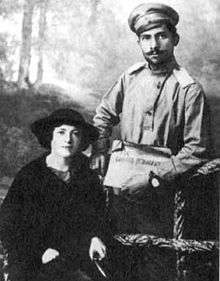
In 1987, American journalist Stuart Kahan published a book entitled The Wolf of the Kremlin: The First Biography of L.M. Kaganovich, the Soviet Union's Architect of Fear (William Morrow & Co). In the book, Kahan made a series of claims about Kaganovich's working relationship with Stalin and his activities during the Ukrainian famine, and claimed to be Kaganovich's long-lost nephew. He also claimed to have interviewed Kaganovich personally and stated that Kaganovich admitted to being partially responsible for the death of Stalin in 1953 (supposedly by poisoning). A number of other unusual claims were made as well, including that Stalin was married to a sister of Kaganovich (supposedly named "Rosa") during the last year of his life and that Kaganovich (who was raised Jewish) was the architect of anti-Jewish pogroms.[18]
After The Wolf of the Kremlin was translated into Russian by Progress Publishers, and a chapter from it printed in the Nedelya (Week) newspaper in 1991, remaining members of Kaganovich's family composed the Statement of the Kaganovich Family in response. The statement disputed all of Kahan's claims.[19]
Rosa Kaganovich, who the Statement of the Kaganovich Family says was fabricated, was referenced as Stalin's wife in the 1940s and 1950s by Western media including The New York Times, Time and Life.[20][21]
Miscellaneous
Kaganovich is responsible for the use of the "eggs and omelette" metaphor in reference to the Great Terror ("Why wail over broken eggs when we are trying to make an omelette!"), a usage commonly attributed to Stalin himself.[22] The expression was used in France as early as 1742, and then more famously in 1796 in reference to a French Royalist counter-revolution in the Vendée.[23]
According to Time magazine and some newspapers, Lazar Kaganovich's son Mikhail (named after Lazar's late brother) married Svetlana Dzhugashvili, daughter of Joseph Stalin on 3 July 1951.[24] Svetlana in her memoirs denies even the existence of Mikhail.[25]
Kaganovich is portrayed by Irish actor Dermot Crowley in the 2017 historical comedy The Death of Stalin.
Decorations and awards
- Order of Lenin, four times
- Order of the Red Banner
- Hero of Socialist Labour (5 November 1943)
References
- Metro.ru Original order on naming the Metro after Kaganovich. Retrieved Archived 10 July 2001 at Archive.today 19 October 2007
- Garthoff, Raymond L. (1994). The Great Transition: American-Soviet Relations and the End of the Cold War. Washington, DC: Brookings Institution. p. 461, n30. ISBN 0-8157-3060-8.
-
Compare: "Kaganovich, Lazar Moiseyevich". Jewish Virtual Library. The American-Israeli Cooperative Enterprise. 2013. Retrieved 2016-05-23.
Born in Kiev province, Kaganovich joined the Communist Party in 1911 [...]. [...] For a number of years he was the only Jew to occupy a top position in the Soviet leadership.
- Rees, E. A. (2013-10-15). Iron Lazar: A Political Biography of Lazar Kaganovich. Anthem Press. ISBN 9781783080571.
- Rees, Edward Afron. 1994. Stalinism and Soviet Rail Transport, 1928–41. Birmingham: Palgrave Macmillan
- Lemkin, Raphael (2009). "Soviet Genocide in the Ukraine (reprint of 1951 article)". Holodomor: Reflections on the Great Famine of 1932–1933 in Soviet Ukraine. Kingston: Kashtan Press.
- Ukraine court finds Bolsheviks guilty of Holodomor genocide, RIA Novosti (13 January 2010)
Yushchenko Praises Guilty Verdict Against Soviet Leaders For Famine, Radio Free Europe/Radio Liberty (14 January 2010) - The Kiev Court of Appeals named the organizers of Holodomor. by Ya.Muzychenko (in Ukrainian)
- "Сталинские списки". stalin.memo.ru.
- http://www.hrono.ru/biograf/kaganov_m.html citing K. A. Zalesskiy, Stalin's Empire
- Simon Sebag Montefiore. Stalin: The Court of the Red Tsar. p. 210.
- Sebag Montefiore, Simon (2004). The Court of the Red Tsar. Phoenix. "Postscript"
- Sebag Montefiore, Simon (2004). The Court of the Red Tsar. Phoenix. p. 668
- editors (1 July 2016). "12 July 1984". Archived from the original on 31 July 2017. Retrieved 6 July 2016.CS1 maint: extra text: authors list (link)
- L. M. Kaganovich, Stalwart of Stalin, Dies at 97
- Parla Kaganovich 'Non siamo dei mostri'
- L. M. Kaganovich, Stalwart of Stalin, Dies at 97
- Kahan, Stuart. The Wolf of the Kremlin: The First Biography of L.M. Kaganovich, the Soviet Union's Architect of Fear (William Morrow & Co, 1987)
- "Statement of the Kaganovich Family". revolutionarydemocracy.org.
- See:
- Life – July 14, 1941. p. 19: "A sister Rosa first lived with Stalin, then after the suicide of his second wife is supposed to have married Stalin"
- Life – March 29, 1943. p. 40: "His sister Rosa is supposedly married to Stalin"
- Time – April 18, 1949: "Lazar Kaganovich, who is Stalin's brother-in-law"
- Time – July 23, 1951: "Lazar Kaganovich, long time politburo member and Stalin's brother-in-law"
- Life – March 16, 1953. p. 22: "Kaganovich, the brilliant and energetic Jew, Stalin's brother-in-law"
- Life – April 13, 1953. p. 168: "Kaganovich (a member of the Politburo and brother of Stalin's third wife)"
- Time – September 7, 1953: "Lazar Kaganovich (Stalin's brother-in-law)"
- The New York Times – November 22, 1953 Kaganovich Decorated: Malenkov's Regime Gives High Honor to Stalin's Brother-in-Law
- Time – February 7, 1955 – "Lazar M. Kaganovich, wartime commissar for transport, reputedly Stalin's brother-in-law"
- Youngstown Vindicator – March 7, 1953: "Rosa Kaganovich"
- Milwaukee Sentinel – June 11, 1960: "Rosa Kaganovich"
- The New York Times – July 27, 1991: "Kaganovich's sister, Rosa"
- Face of a Victim is the autobiography of Elizabeth Lermolo, a woman who fled Russia, arriving in the US in 1950. The book tells the story of the death of Stalin's second wife Nadezhda (Nadya) as witnessed by Natalia Trushina, who was employed as a housekeeper in Stalin's home, and who in 1937, Elizabeth Lermolo shared an NKVD prison cell with. Rosa (Roza) Kaganovich, with whom Stalin was having an affair, was whom Stalin and his wife were arguing about before she died. This book alleges Stalin struck Nadya a fatal blow with his revolver. Robert Payne mentioned Rosa in a 1965 biography of Stalin, where he said: "At such parties he was always inclined to drink dangerously. Something said by Nadezhda – it may have been about another woman, Rosa Kaganovich, who was also present, or about the expropriations in the villages which were dooming the peasants to famine - reduced Stalin to a state of imbecile rage. In front of her friends he poured out a torrent of abuse and obscenity. He was a master of the art of cursing, with an astonishing range of vile phrases and that peculiarly." (The Rise and Fall of Stalin, p. 410) Harford Montgomery Hyde also wrote about Rosa in his 1982 biography of Stalin: "However, it has been established that after the birth of their second child Svetlana, Stalin ceased to share his wife's bed and moved into a small bedroom beside the dining room of the Kremlin apartment. It has also been stated that, after the Georgian singer's departure for Afghanistan, the woman who was the chief cause of their difference was another dark-eyed beauty, the brunette Rosa Kaganovich, sister of the commissar Lazar, with whom Molotov had previously had an affair. At all events, by 1931 Nadya was thoroughly disillusioned with her husband and most unhappy." (Stalin: The History of a Dictator, p. 260)
- "RUSSIA: Stalin's Omelette" Time October 24, 1932
- Vuolo, Mike (2013-12-30). "Let's Resolve in the New Year to Stop Using That Expression About Breaking Eggs and Making Omelets". Slate. ISSN 1091-2339. Retrieved 2016-03-23.
- "Social Notes" Time July 23, 1951
- Alliluyeva, Svetlana (1969). Only One Year. Harper & Row. p. 382.
Further reading
- Rees, E.A. Iron Lazar: A Political Biography of Lazar Kaganovich (Anthem Press; 2012) 373 pages; scholarly biography
- (in Russian) Collection of six Kaganovich bios at Khronos
- Radzinsky, Edvard, (1996) Stalin, Doubleday (English translation edition), 1996. ISBN 0-385-47954-9
- Rubenstein, Joshua, The Last Days of Stalin, (Yale University Press: 2016)
External links
| Wikiquote has quotations related to: Lazar Kaganovich |
| Wikimedia Commons has media related to Lazar Kaganovich. |
- Profile at http://www.hrono.ru (in Russian)
- Newspaper clippings about Lazar Kaganovich in the 20th Century Press Archives of the ZBW
- Lazar Kaganovich at Find a Grave
| Political offices | ||
|---|---|---|
| Preceded by Pavel Yudin position created |
Minister of Building Materials Industry 1956–1957 1946–1947 |
Succeeded by Ivan Grishmanov Semyon Ginzburg |
| Preceded by position created |
Chairman of State Committee on Labor and Salary 1955–1956 |
Succeeded by Aleksandr Volkov |
| Preceded by ? |
First Deputy Chairman of the Council of Ministers 1953–1957 |
Succeeded by ? |
| Preceded by position created |
Chairman of State Committee on Materiel-Technical Supply for National Economy 1948–1952 |
Succeeded by Ivan Kabanov |
| Preceded by Andrei Khrulyov Aleksei Bakulin Andrei Andreyev |
People's Commissar of Commuting Routes 1943–1944 1938–1942 1935–1937 |
Succeeded by Ivan Kovalyov Andrei Khrulyov Aleksei Bakulin |
| Preceded by ? |
Chairman of Council on Evacuation 1941–1941 |
Succeeded by ? |
| Preceded by position created |
People's Commissar of Oil Industry 1939–1940 |
Succeeded by Ivan Sedin |
| Preceded by position created |
People's Commissar of Fuel Industry 1939–1939 |
Succeeded by position liquidated |
| Preceded by Valeriy Mezhlauk |
People's Commissar of Heavy Industry 1937–1939 |
Succeeded by position liquidated |
| Party political offices | ||
| Preceded by Nikita Khrushchev Emanuil Kviring |
1st Secretary of the Communist Party of Ukraine 1947–1947 1925–1928 |
Succeeded by Nikita Khrushchev Stanislav Kosior |
| Preceded by ? |
1st Secretary of the Communist Party of Moscow City 1931–1934 |
Succeeded by Nikita Khrushchev |
| Preceded by Karl Bauman |
1st Secretary of the Communist Party of Moscow Oblast 1930–1935 |
Succeeded by Nikita Khrushchev |